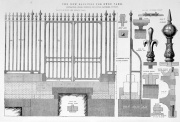Difference between revisions of "Robinson and Cottam"
| Line 6: | Line 6: | ||
of London | of London | ||
1852 [[Edward Cottam]] (1816-1904) went into business with [[Francis Robinson]], formerly of [[Bramah and Robinson]]. Large statues were cast at the Pimlico Works of '''Robinson and Cottam'''. | 1852 [[Edward Cottam]] (1816-1904) went into business with [[Francis Robinson]], formerly of [[Bramah and Robinson]]. Large statues were cast at the Pimlico Works of '''Robinson and Cottam'''. | ||
Robinson | Robinson and Cottam guns were used in the American Civil War | ||
The firm was formed into a limited company with Mr Cottam as managing director | |||
The foundry was later moved to Battersea, where the large iron cylindrical sections (over 20 ft diameter) for the piers of the [[Albert Bridge]] were cast in 1871.<ref>'The Engineer' 17th November 1871</ref> (See illustration) | |||
The Battersea Works also produced horseshoes by machine, as well as a "volley gun" invented by Edward Cottam <ref>[http://www.wimbledonsociety.org.uk/userfiles/080605_WimSocNews_June_08a.pdf]pdf version of The Wimbledon Society Newsletter, June 2008, page 4</ref> | |||
1875 The company was put into liquidation; Mr Cottam retired. | |||
Revision as of 14:14, 7 March 2017
of London
1852 Edward Cottam (1816-1904) went into business with Francis Robinson, formerly of Bramah and Robinson. Large statues were cast at the Pimlico Works of Robinson and Cottam.
Robinson and Cottam guns were used in the American Civil War
The firm was formed into a limited company with Mr Cottam as managing director
The foundry was later moved to Battersea, where the large iron cylindrical sections (over 20 ft diameter) for the piers of the Albert Bridge were cast in 1871.[1] (See illustration)
The Battersea Works also produced horseshoes by machine, as well as a "volley gun" invented by Edward Cottam [2]
1875 The company was put into liquidation; Mr Cottam retired.





